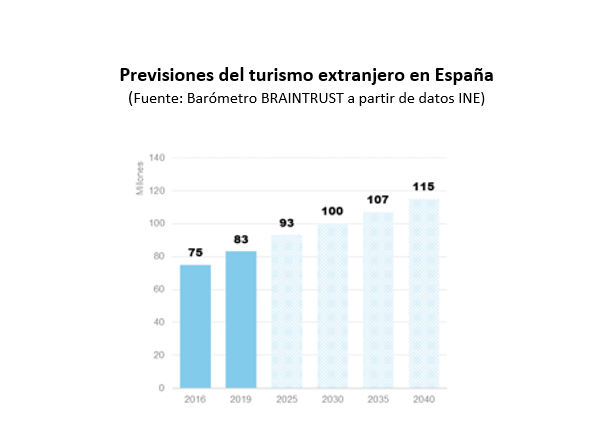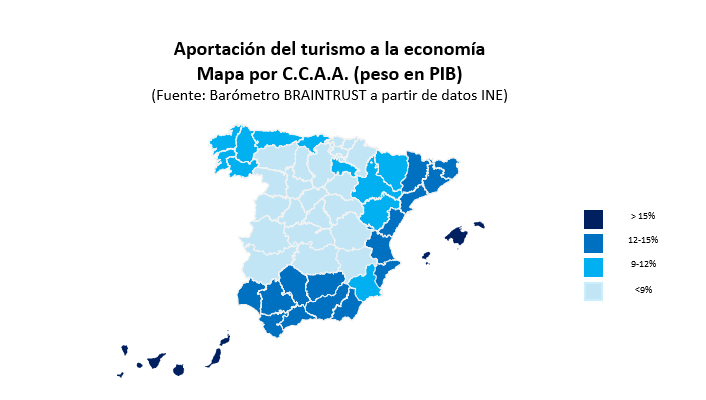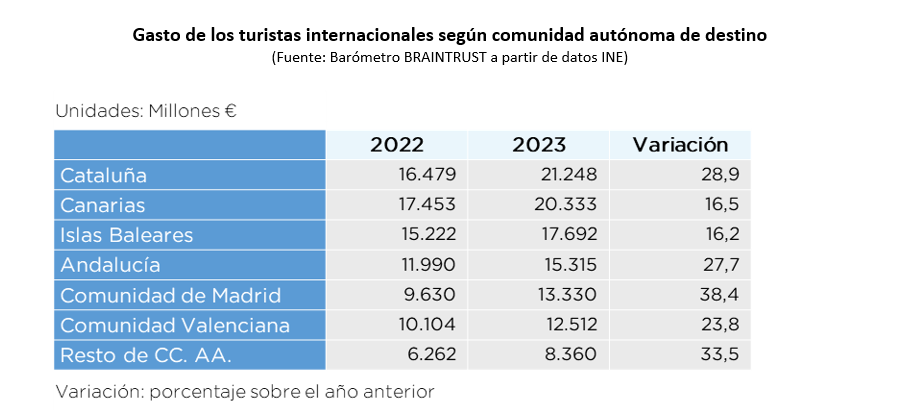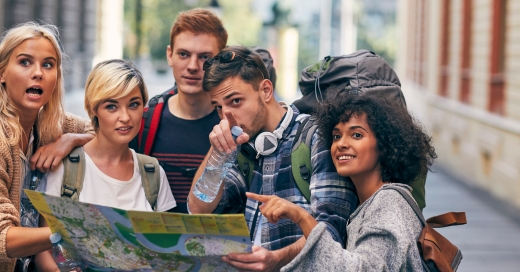The consulting and professional services firm BRAINTRUST, a leader in the tourism sector, has issued a new report of its Tourism Barometer estimating the forecasts of foreign travelers arriving in our country in the coming years, an area where, as the company said last March, there will be a new record number of visitors and spending in 2024.
With a forecast of more than 91 million international tourists for this year, and an expenditure of around 125,000 million euros, estimates point to significantly surpassing these figures in the coming years. The international context, the evolution of the economy, and the actions carried out by the different destinations may have an influence in continuing to surpass records not only in number but also in spending, together with the promotion being carried out by Turespaña abroad.
Spain will become the world leader reaching 115 million foreign tourists in the next few years
The consulting firm affirms that a sustained growth in foreign tourism is expected over time, positioning Spain as the leading market in international travelers in the coming decades, reaching 115 million travelers around 2040, placing it at the top of the podium, as the number one receptive market for tourists in the world, ahead of France.

The weight of tourism in GDP will continue to grow to over 15%.
In fact, the autonomous communities and municipalities in Spain are increasingly updating and planning their tourism policies with a view to growth, where it is expected that nationally the weight of tourism will exceed 15% in the coming decades, a figure that is already exceeded in communities such as the Balearic and Canary Islands.
Some places, such as incipient destinations, will look for quantity and others, such as mature destinations, will look for quality, since this tourism industry accounts for a large part of the GDP of the different territories, as shown in the map prepared by BRAINTRUST.
For Ángel García Butragueño, Director of Tourism at BRAINTRUST: "Tourism is once again proving to be the economic engine of our country, with an overwhelming strength and resilience worthy of praise, whose weight will increase in the future thanks to our extraordinary value proposition. Spain is called to lead the industry at a global level in a sustainable tourism model, both from an economic point of view, an area where it has worked in the past, and from a social and environmental point of view. To this end, it is advisable to implement a State policy on sustainable tourism, such as the one planned by the Secretary of State for Tourism between now and 2030, which was joined by the Conestur manifesto on the subject just a few days ago. Spain cannot and should not live without tourism, but that tourism must be very different, with an absolute paradigm shift. At BRAINTRUST we work for a new model of sustainable tourism, designing new strategies for our clients, unveiling business opportunities in a new era, to obtain the best results in the short, medium and long term".
Traditional source markets will reduce their share of total arrivals to below 70%.
In this dilemma of the quantity or quality of international travelers, depending on the needs of each destination, some questions arise as to what the new international tourists will be like in the future, since Spain is benefiting from the economic, social and geopolitical situation in the world, which must be taken advantage of, building loyalty among foreign tourists, offering them unique experiences that allow them to repeat and a higher average daily expenditure.
To begin with, it is very likely that these new tourists will not be European, and if they are, they will not be from the more traditional markets such as the United Kingdom, Germany or France, reducing the weight of traditional outbound markets to below 70%.
While European outbound markets currently account for three-quarters of travelers, the increase in travelers from the Americas (both the U.S. and the rest of the continent) and the rest of the world, especially Asian countries, indicates that at least one-third of travelers will not come from traditional outbound markets.
Spending will be increasingly higher, reaching double the figures in average daily spending compared to 2017
New visitors to Spain in the future will not come only for the relaxation of sun and beach. Increasingly there is a trend towards "mixed" travel, i.e. leisure mixed with work, an event (concert, shows...) combined with a few days of relaxation or even cultural and gastronomic experiences accompanied by a little sun.
BRAINTRUST estimates indicate that more than 25% of travelers will come for this type of mixed motivations, which shows the success of the work carried out by the different administrations and companies in diversifying our offer.
The weight of the summer months in the total number of arrivals is gradually decreasing and its weight is expected to fall below 30% (in number of travelers) compared to the 38% it represented years ago.
In line with the different motivations for visiting Spain, a diversification of destinations will also be observed. The TOP 6 Autonomous Communities that currently account for more than 90% of traveler arrivals (Andalusia, the Balearic Islands, the Canary Islands, Catalonia, the Community of Valencia and the Community of Madrid) will see their share reduced in favor of others with less current weight.
This reduction will not be rapid, but it will take place gradually, as our forecasts for the coming years indicate, where regions such as Galicia, Asturias, the Basque Country, Navarre, Castilla León, Castilla La Mancha and Extremadura will gain followers for their tourism proposal, far from the traditional sun and beach.

Similarly, it is quite likely that the new visitor will not travel with a package tour, as almost 30% will do so; with regard to their accommodation, forecasts indicate that, while 2 out of 3 will stay in hotel establishments, 1 out of 3 will opt for another type of accommodation.
Linked to all of the above, an average of between 2,000 and 3,000 euros is expected to be spent on vacation by new international travelers visiting our country, which, taking into account their stay (approximately 8 days), means an average daily expenditure of between 200 and 300 euros, almost double what was spent before the pandemic.
In fact, the consultancy estimates that in 2030 average daily spending would double compared to 2017, with an approximate figure of 280€ per day, and between 2035 and 2040 average daily spending could rise to 340€ per day, doubling the figure for 2022.
For José Manuel Brell, Partner in charge of the Quantitative Studies and Models practice, and of the Tourism and Leisure Industry at BRAINTRUST: "Our studies announce a profile of the new foreign tourists that is relatively different from the one we have traditionally had, both in their origin and in their motivations, leading to a higher average daily expenditure in the coming years. A tourist that is more similar to the prototype we talk so much about in the speeches where quality and not quantity is pursued. This is due both to changes in global society and to the efforts being made by some actors to attract a different type of tourism, especially the extraordinary effort of Turespaña to position our country as a rich, diverse, safe destination, with different types of tourism, which increasingly attract visitors from abroad. Our forecast points to a constant growth of foreign tourism, in view of the continuing geopolitical circumstances, and in view of Spain's unbeatable offer, and we will have to prepare ourselves to receive those 115 million foreign travelers that our mathematical models estimate. However, to achieve these figures we have to ensure that visitor arrivals bring more benefit to our society than the harm they cause. This is the only way to achieve a successful model.







